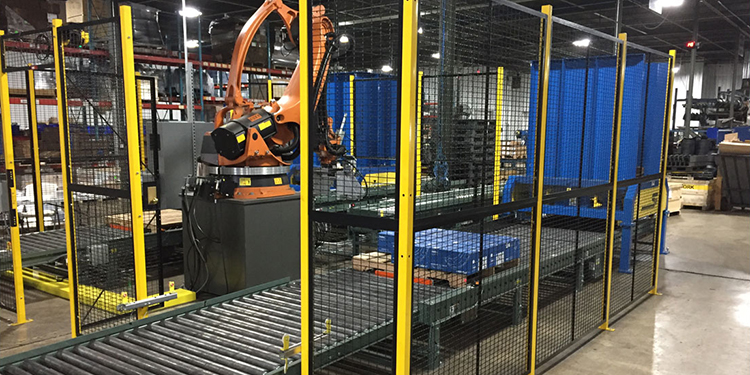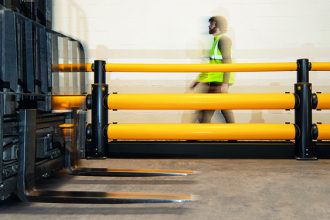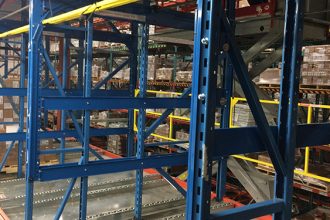Protect Employees From Robotic And Automated Equipment Hazards

When installing robotic and automated systems in a warehouse, distribution center, or factory, it is important to secure the perimeter of the equipment and machinery. One way to keep personnel out of the way of robotic or automated equipment used in assembly, manipulators, palletizers, welders, or other moving equipment, is to erect a barrier around the hazard using guarding panels secured by posts.
To determine which type of guarding material should be used, as well as how the barrier should be constructed, the facility and equipment owner must first perform a risk assessment. This includes identifying the hazards associated with the system, determining who might be at risk of harm from the equipment, evaluating the potential dangers, deciding how to best prevent them, and implementing the appropriate guarding type that will best mitigate those hazards.
Additionally, there are two standards that should be consulted when determining the type of automation guarding that should be utilized:
- ANSI/RIA R15.06-2012: American National Standard for Industrial Robots and Robot Systems – Safety Requirements. This standard provides guidelines for the manufacture and integration of industrial robots and robot systems with emphasis on their safe use, the importance of risk assessment and establishing personnel safety.
- ISO 13857:2019 – Safety of Machinery – Safety Distances to Prevent Hazard Zones Being Reached by Upper and Lower Limbs. This document establishes values for safety distances in both industrial and non-industrial environments to prevent machinery hazard zones from being reached. It also outlines the appropriate safety distances for protective structures.
In the U.S., the minimum height of the barrier surrounding the robotic automation equipment is 60 inches. If there is an opening between the floor and the bottom of the barrier panels — called the “sweep space” — it must be no more than 6 inches tall. The amount of space between the maximum point of the robot’s reach and the barrier varies depending on the barrier material’s openings, if it has any. For example, if a panel has 2-inch square openings, the barrier must be at least 33.5 inches from the hazard; if the openings are smaller, such as 1.25-inch, the barrier can be placed as close as 4.7 inches from the hazard.
For operations that seek to prevent personnel from encroaching within the working reach of the robot or automated system, a barrier constructed of wire mesh guarding serves as both a physical and visual obstruction. There are two types of wire mesh guarding: welded wire, which is comprised of straight vertical and horizontal wires welded at each intersection; and woven wire, which is constructed of vertical and horizontal crimped wire that is woven together alternately, over and under, and lock-crimped at each intersection for stability. As noted above, the closer the wires are spaced together, the closer the barrier panels can be positioned to the robot.
Facilities seeking to protect employees’ eyes from the bright light emitted from arc flashes caused by welding robots can add a weld curtain to the inside of their wire mesh panels. These curtains are tinted and come in a variety of shades and opacities, significantly reducing the amount of light that passes through the barriers. To ensure maximum protection, the curtains typically span the full height and width of each panel. Applications with laser cutting robots or machinery often elect to use a solid metal panel when installing their protective barrier. Typically used with Class IV lasers, the solid panels ensure that no laser beams pass through the guarding.
Operations that wish to retain visibility into the robotic or automated work cell while still preventing personnel from encroaching within its area can also chose to Lexan panels made of clear polycarbonate. These panels prevent particles, dust, or other debris from entering or exiting the robotic work area.
Other key considerations when creating a barrier around robotic and automated equipment include the positioning and securing of access points. Each entrance door should be equipped with a shut-off device that must be activated to stop the automated equipment prior to unlocking the door and entering the restricted area. For redundancy, a safety interlock that automatically shuts down the equipment when the door is opened should also be integrated into the system. Additionally, robot or automation shut-off devices and safety interlocks should be used at every service or access panel that can be removed for equipment maintenance. These ensure that the equipment will be off prior to any personnel approaching it from inside the guarding and prevent the automated system from striking the employee.
Looking for more details about using guarding to protect your operation’s personnel? The members of the Protective Guarding Manufacturers Association (ProGMA) have produced a series of educational videos showing multiple areas within a facility where these and other guarding systems should be used.



